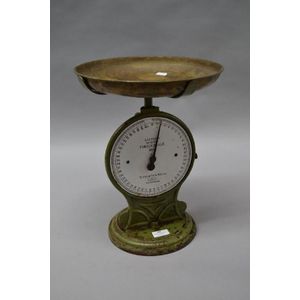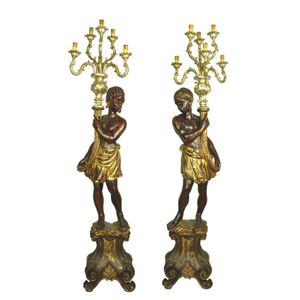Bohemian Opaline Glass Portrait Vases, 19th Century
A pair of large Bohemian opaline glass portrait vases, 19th century, the pedestal baluster vases with gilt embellished oval half portraits of young women with flowers in their hair in polychrome colours, trimmed throughout with gilded bands, height 45.5 cm
You must be a subscriber, and be logged in to view price and dealer details.
Subscribe Now to view actual auction price for this item
When you subscribe, you have the option of setting the currency in which to display prices to $Au, $US, $NZ or Stg.
This item has been sold, and the description, image and price are for reference purposes only.
- Baluster (glass) - An architectural term for a column in a balustrade or staircase.
When used to describe glass, it can either refer to the shape of the stem of a wine glass, being slender above and pear shaped below, or the shape of the whole vessel, usually a vase. In fact the baluster shape is often described as being vase-like.
The description of a vase as being of baluster shape covers a wide variety of shapes that often bear no resemblance to the original architectural form. - Opalescent / Opaline - The descriptions of glass as "opalescent" or "opaline" are often used interchangeably by dealers and auction houses. At the upper end of the scale, opalescent / opaline glass can refer to the opal-like milky blue glass produced by Lalique and Etling. It also refers to the pressed glass mass produced in Britain from the 1840s with a milky white edge as sugar-basins, milk jugs and vases were made in great quantities for the mass market, and were sold at fairs along with Staffordshire figures and wooden dolls. A less common type of opalescent glass was made from two layers of glass blown into a mould.
- Gilding - Gilding is a method of ornamentation whereby a thin sheet of gold metal is applied to items made of wood, leather, ceramics, glass and silver for decorative purposes.
For furniture including mirrors, the sheet of gold is usually applied over a coating of gesso. Gesso is a mixture of plaster of Paris and gypsum mixed with water and then applied to the carved wooden frames of mirrors and picture frames as a base for applying the gold leaf. After numerous coats of gesso have been applied, allowed to dry and then sanded a coat of "bole", a usually red coloured mixture of clay and glue is brushed on and allowed to dry, after which the gold leaf is applied. Over time parts of the gilding will rub off so the base colour can be seen. In water gilding, this was generally a blue colour, while in oil gilding, the under layer was often yellow. In Victorian times, gilders frequently used red as a pigment beneath the gold leaf.
Metal was often gilded by a process known as fire gilding. Gold mixed with mercury was applied and heated, causing the mercury to evaporate, the long-term effect of which was to kill or disable the craftsman or woman from mercury poisoning. The pursuit of beauty has claimed many victims, not the least of which were the artists who made those pieces so highly sought after today. - Polychrome - Made or finished in many colours. For furniture, it is used to indicated a painted finish.
This item has been included into following indexes:
-
Bohemian (Czech Republic) glass wares
- various wares 458
- vases 237
Visually similar items

A French provincial style wrought iron based parquetry top centre table 136 cm diameter x 73.5 cm high.
Sold by
in
for
You can display prices in $Au, $US, $NZ or Stg.

Set of Salter scales, approx 40 cm high
Sold by
in
for
You can display prices in $Au, $US, $NZ or Stg.

Lionel Lindsay 'Dawn' etching 34/75, signed lower left, 15 x 24 cm
Sold by
in
for
You can display prices in $Au, $US, $NZ or Stg.

A pair of gilt and silvered blackamoor figures wired for electricity 170 cm high
Sold by
in
for
You can display prices in $Au, $US, $NZ or Stg.
